
The French Camino, Aire sur l'Adour to Roncevalles, April and May, 2014
by Linden B. (Lindy) Sisk

|
The French Camino, Aire sur l'Adour to Roncevalles, April and May, 2014by Linden B. (Lindy) Sisk
|
(Note: each of the pictures on this page may be clicked on, to get a larger view of the picture.)
Some of the pictures were taken by Cindy Crochet, and are used by permission.
In 2013, a group of 8 people, friends or those about to be, walked 210 miles of the Camino de Santiago in Spain, from Leon to Santiago de Compostella, a story told here. We had so much fun on that trip, when Tristan and Alex MacDonald, who had organized that trip, suggested that we do a trip on a French section of the Camino, everyone in the group immediately signed on, except one, for whom a replacement was found.
So, the group became Tristan and Alex MacDonald, Bob and Ann Sullivan, Cindy Crochet and I, Wilf Cameron, and Jack Merwin. All of those except Cindy and me live in or near St. Augustine, Florida.
Since Cindy had never been to France, we flew into Paris a couple of days early, so we could see some of the sights of Paris. The rest of the group flew into Paris on Monday, April 28th, to meet us at Orly Airport for a flight to Biarritz, from which a van would transport us to Aire sur l'Adour to start the hike.
We left New Orleans and flew to Atlanta, then caught a flight to Paris overnight on April 26th, arriving around 2 PM on Sunday the 27th. I got some sleep on the plane, assisted by my Bose QC20i noise-cancelling headphones, which are wonderful — if you are going to fly much, I highly recommend these as an aid to sleeping on the plane. They fit in your ear, unlike the earlier bulky models, and they almost entirely eliminate jet noise — when you turn them on, you will think you have gone deaf. I use them when cutting the grass, too. The "i" model has a microphone and audio controls for the iPhones, but the model without the "i" will work on most phones or audio gear. I used them on our trip to Chile last year, and got solid sleep on the plane. They have a rechargeable battery good for up to 16 hours, and the sound reproduction is up to the usual awesome Bose standard.
Cindy took this lovely picture of the fields near Paris from the airplane.
We bought tickets for the RER train to downtown Paris, where our hotel was located on the Isle St. Louis. The train is by far the fastest and cheapest way to get from the airport to Paris, if there is a Metro stop near where you are staying.
A bit of advice for traveling to Europe. Don't buy Euros prior to getting there. If you take the train into town, you will need a chip-and-pin credit card to get train tickets — your regular ATM or credit card will not work, and it's really nice to be able to buy train or Metro tickets from the machines. (See Chip and Pin Credit Cards.) Your regular debit/ATM card will work to get cash from ATM machines. Avoid those in the airports, as they tend to charge less-advantageous exchange rates. ATM machines I used to get cash on the street and at banks all gave me cash at a price within a U.S. penny of the official exchange rates, which is a much better exchange rate than your bank will charge you for Euros prior to leaving the U.S. - one of my banks I checked wanted 6 percent of the amount being purchased. And, if you buy too many before leaving, they are going to screw you on buying the extra amount back, too. BTDT. Don't.
Not realizing that we would arrive the day after leaving, I had made hotel reservations to include the night of the 26th, which meant that we paid for an extra night that we weren't there. Oh, well, I try to be perfect, but I don't have much success at it.
We arrived at our hotel, straightened out the reservation error, and dropped our bags in the room. Since the Cathedral of Notre Dame was only a couple of blocks away, we went over there, and arrived during a mass celebrating the canonization of Pope John Paul II and Pope John XXIII, an event celebrated that day around the world. The church was packed, and beautifully lit.
The Cathedral of Notre Dame is often thought of as a tourist attraction, which, of course, it is, but it is also a working Catholic church, with Mass held one or more times per day.
The next day, having recovered somewhat from the 7 hour time change, we toured Paris. We avoided the museums, which are time-consuming. The Louvre has some 65,000 objects in miles of corridors, and justifies days if you really want to see the collections. If you are going, though, with time, I highly recommend the Musee de Orsay, which is smaller, and with a much more selective collection.
The steets of Paris are sometimes narrow — this is the one our hotel was on, on the Isle St. Louis — and parking is often problematic... Many of the cars we saw had marks on the fenders from extreme parking.
 Notre Dame, in the morning |
 Our street |
 Lessee, how close can we get? |
On several of the bridges across the Seine, people had placed locks as a symbol of their lasting relationship with someone they love. They then throw the keys in the Seine, where they are often removed by the Sapeurs and Pompiers of the Fire Brigade of Paris, who dive in the river to remove foreign objects, like keys, cars, bodies, and other trash. Flowers were everywhere in Paris — and, actually, everywhere in France.
 Locks |
 |
 Jardin des Tuileries |
We toured the town on a bus run by OpenTours. They run four different routes in Paris, and you can hop on and off at any stop, and get back on later, or elsewhere. What's nice is you get a set of earphones when you get on, and each seat has plugs for the phones, which will narrate the tour in any of about 10 different languages, including English. A ticket is also good on one of the boat companies which runs tours on the Seine. I bought tickets for us online before going. You print a voucher, which you just give to a driver, who will give you the actual tickets, and the voucher can be used on any day, so you don't have to specify a date.
We wandered around town. Cindy had promised a grandson a picture of her by the Eiffel tower, which we took. We didn't go up in the tower itself. If you want to go, it's considered insane not to make reservation online in advance, which avoids long ticket lines. After that, we wandered through the Tuilieries Garden, then along the Seine, people watching, and relaxing. We got back on another OpenTour bus, and went to visit another historic church, then hopped back on the bus. We ate a delicious lunch in a Brasserie, and just spent the day wandering around.
On one web site whose profile wanted an occupation, I listed myself as a flaneur, and Paris is the city where the term originated, and the city superbly fitted to that occupation. So, we were flaneurs for the day.
On Tuesday, we had a leisurely breakfast at the hotel, then packed up and took the RER train out to Orly to meet the rest of the group. They had flown overnight into Charles de Gaulle airport, and took a van to Orly. They were, understandably, tired. We used the "express" kiosks to get our boarding passes and print our bag tags, only to find out that we had to stand in line with everyone else to drop the bags off, so the kiosks were a waste of time. The flight to Biarritz was uneventful, and we were met by our driver, who drove us to Aire sur l'Adour. We were split into two different places, because the tour operator had made a mistake in the number of people, and the place we should have all been together was full.
But the town was small enough that it wasn't a problem, and we all ate in the same place except for breakfast. Bob, Ann, Wilf, and Jack got the best of that, as they stayed in a small guest house with great rooms run by a delightful woman, who was a great cook and went out of her way to make them welcome, while Tristan, Alex, Cindy, and I were in a more modern hotel, where the heat did not work, and the proprietor was unfriendly and unhelpful — although we informed him that the heat didn't work after the first night, it was not fixed.
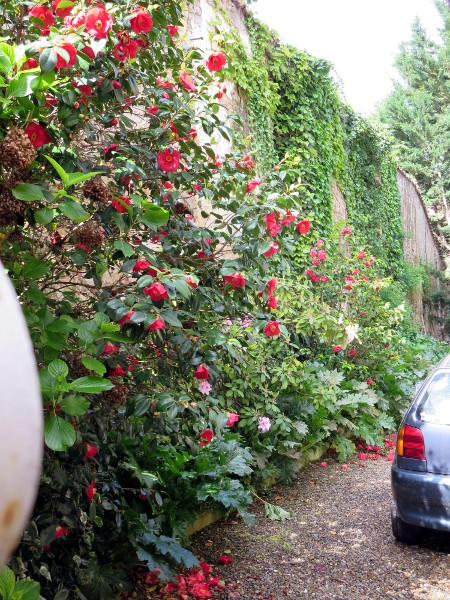 Lovely flowers in Aire sur l'Adour |
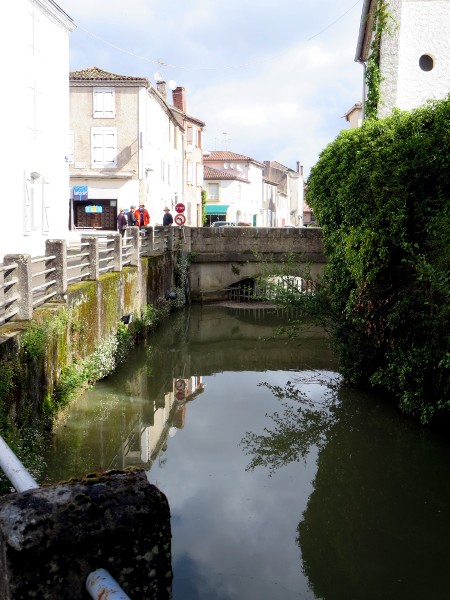 |
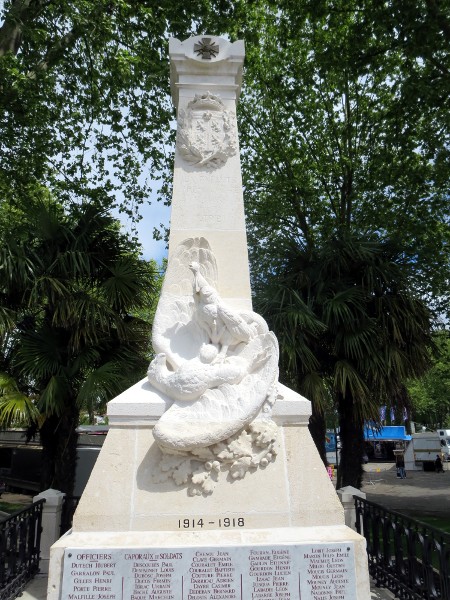 Monument to the Great War |
We spent two nights in Aire sur l'Adour, which allowed the rest of the group to catch up on their sleep from the long transatlantic flights. The second night, we had dinner at a small restaurant outside of town. The food was wonderful. We were picked up by our host, Patrick, and his brother, in two cars, and driven to the restaurant. Patrick and his Tahitian wife run the restaurant, which had been in his family for many years.
Thursday, we began our walk on a rainy morning. It was a good day to be leaving town, as that night began a festival for serious drinkers, as noted in the picture of the poster for the festival at right, and the town was not a good place to be. Some of the shopkeepers put plywood over the windows.
We walked about 16 miles to Miramont-Sensaq. There our half of the group got the best of the reservation split, as we stayed at the wonderful Maison du Bos, with lovely grounds and a beautiful room. We all had dinner at the Maison du Bos, along with two French couples. Both of the men and one of the women spoke excellent English — one had spent several years in Houston in the banking industry. They were also walking on the Camino, mostly staying in the same places we were, and we would came to know them very well. They were delightful hiking companions.
 On the path to Mirramont-Sensacq |
 Maison du Bos |
 Maison du Bos |
Friday, we walked about 14 miles to Larreule. As always, the countryside is the star. All photos below are by Cindy.
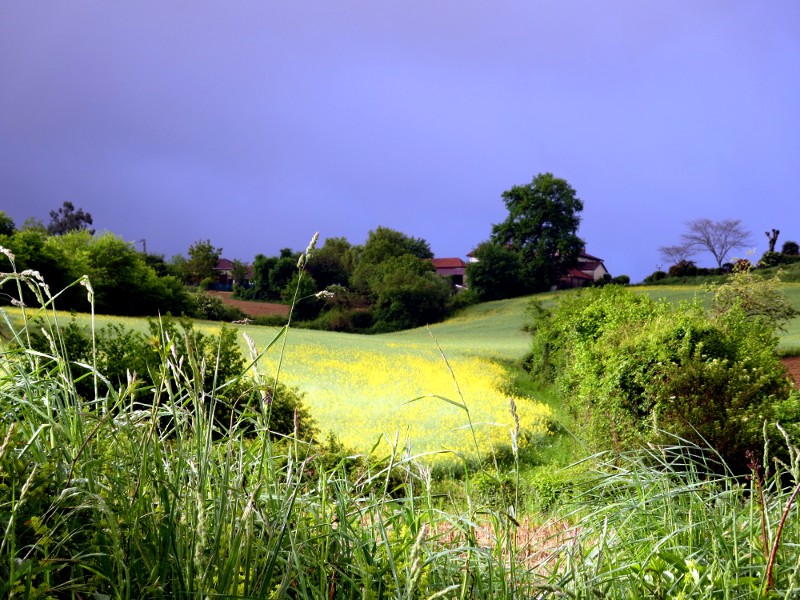 |
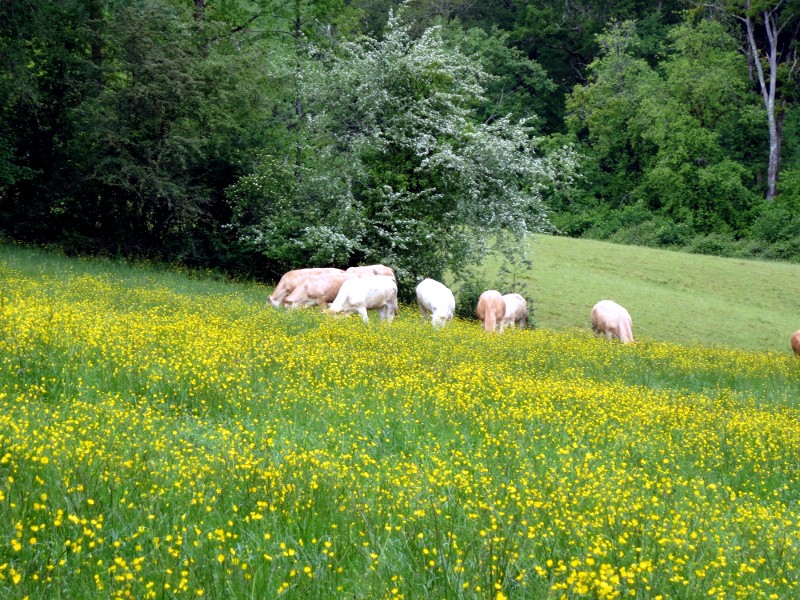 |
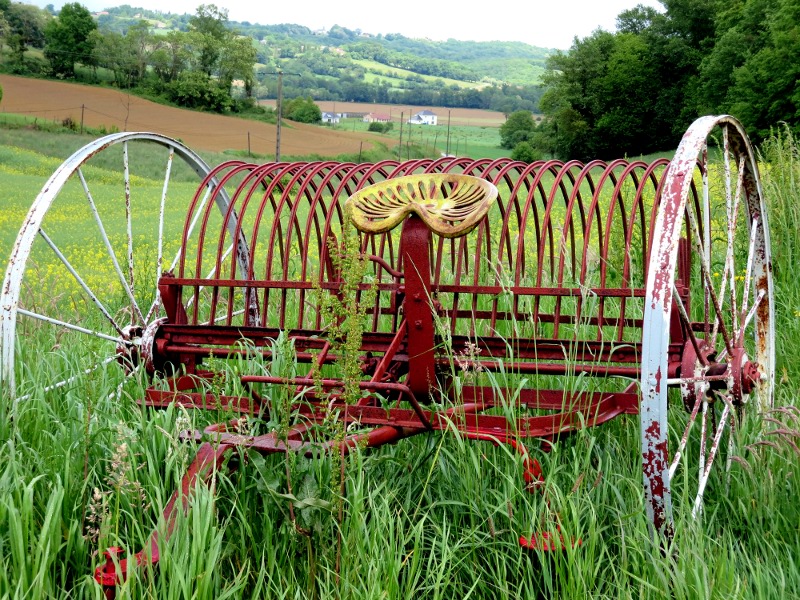 |
Larreule was once the site of a great abbey and monastery in the region known as the Bearn. The monks of Larreule were clergymen: their vocation was to pray, write, and manage parishes. They were also warriors, fighting alongside the princes of Bearn, mainly during the crusades. The abbey was damaged and closed in 1569 during the religious wars. It was reopened in the 17th century, but never regained its prominence, and in 1789, the monastery and buildings which housed pilgrims were demolished. Only the parish church, still in use, remains. This is the interior of that wonderful, centuries old church.
That night, we all stayed in a delightful maison which was well off the Camino, so we were picked up by van. We had been walking in the rain and mud much of the day, and we used the runoff from the roof of the shelter in front of the church to rinse the mud off our shoes and pants. Because of the reservation problem, we had two rooms with 4 people in each room. There was enough room, though, and we had a quiet night.
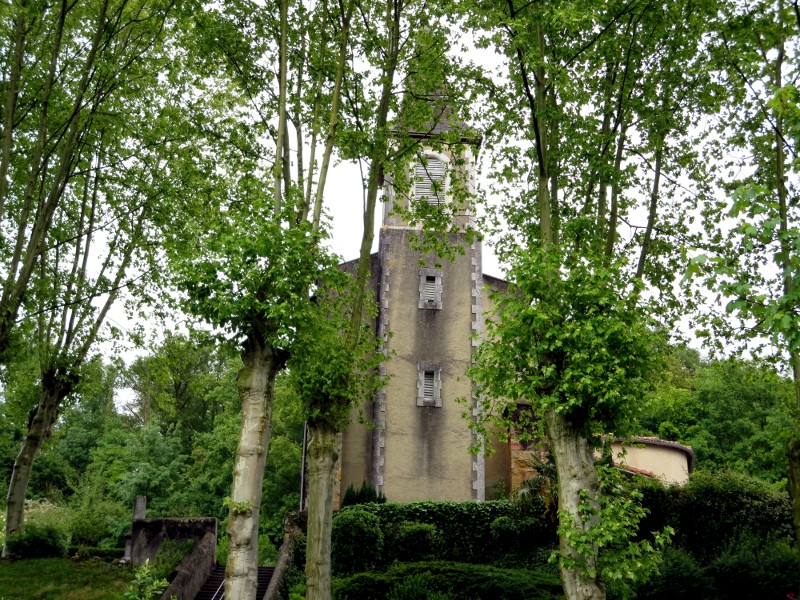 The outside of the church |
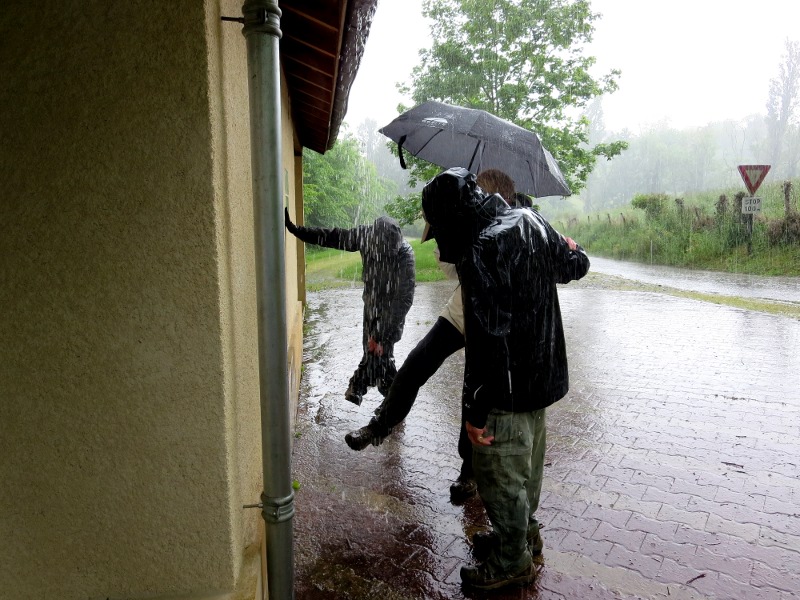 Washing off the mud |
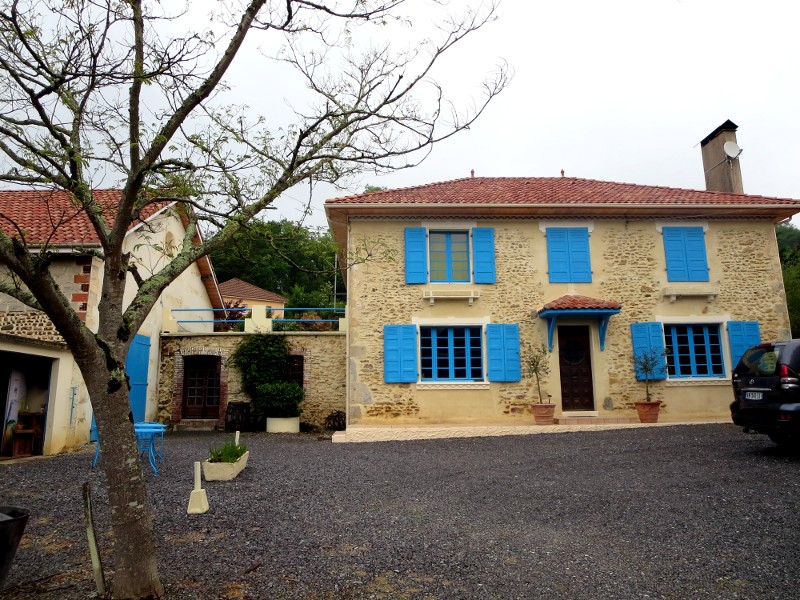 Accomodations at Larreule |
The distances this year were more reasonable than last year, when there was one day which was 22 miles, so we were less hurried walking. We were following a route in France known as the GR65, which is a route which starts in Geneva, Switzerland, and continues south and west across France to the border with Spain, a distance of around 700 miles. It is well marked with red and white stripes, as shown below.
 Go Straight On |
 Turn Left |
 Turn Right |
 This is not the route |
On Saturday, we walked to Navarrenx, a delightful walled city. That day, Cindy developed a blister on the big toe of her right foot, which ended her walking for the next 4 days. We stayed in a delightful hotel right on the main square of the city.
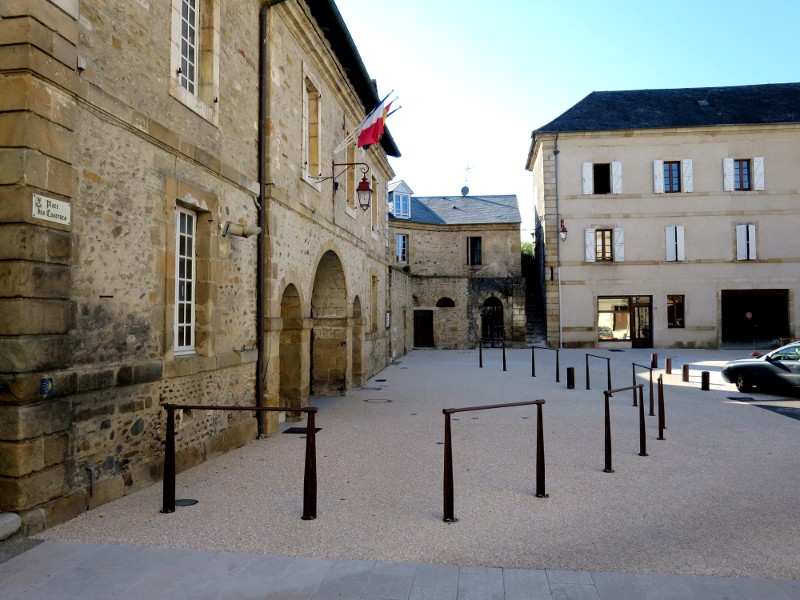 The Barrack Square by the Arsenal |
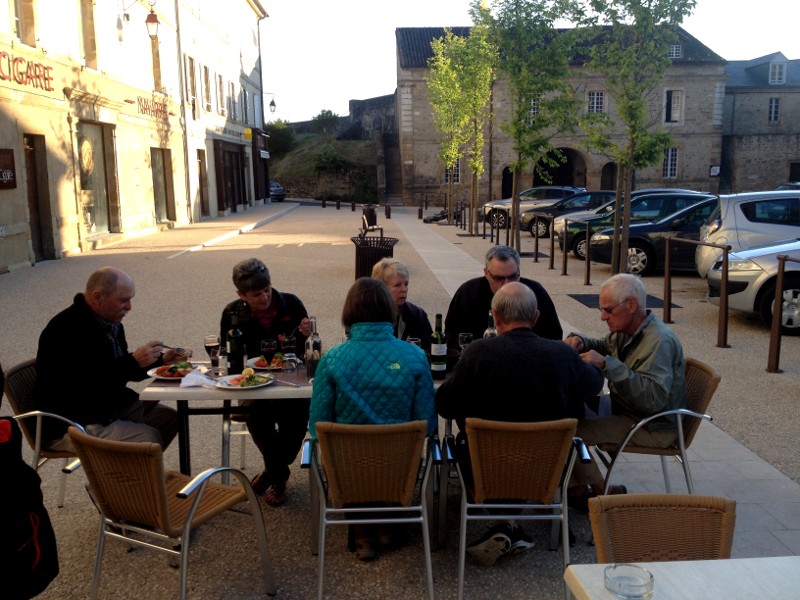 The gang having dinner in the square |
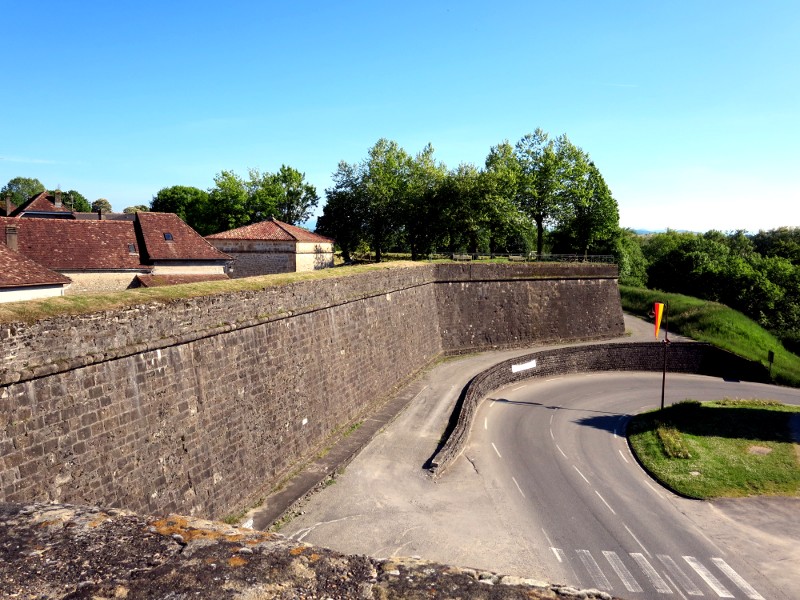 The west wall |
Sunday, the rest of the group walked the 11 miles to the small village of Lichos. Cindy and I stayed in town to get a pharmacist to look at her foot. He gave her some anti-bacterial cream to put on the blister, along with a neat bandage roll that allowed you to cut a bandaid-like bandage to whatever size you needed. We took a taxi to Lichos. Cindy wanted me to walk with the group, which I vetoed. As I had gone through all 5 levels of the Rosetta Stone French course before we left, I could communicate reasonably well, and I wasn't about to leave Cindy alone in town to get her foot looked at, and then try to catch a taxi to Lichos, when she could not speak any French. So, we got to Lichos before the rest of the group, found the house we were staying at, and had some lunch which we had brought with us from the grocery store in Navarrenx. The rest of the group showed up, and we relaxed and had a delightful dinner, prepared for us by the lady who ran the maison and a Portuguese woman who came in to help her clean and cook. It was four courses: soup, pate de fois gras, duck, and Peach Melba for desert. We were all stuffed.
Jack had developed some kind of illness, and didn't feel like walking, so Monday he and Cindy took a taxi to the next town, St. Palais, and I walked with the group. It was a longer day than we expected, and that day we had the only route-finding problem of the entire trip, as we had to get off the GR65 to get to town, and that route was poorly marked — but we did eventually find it.
 |
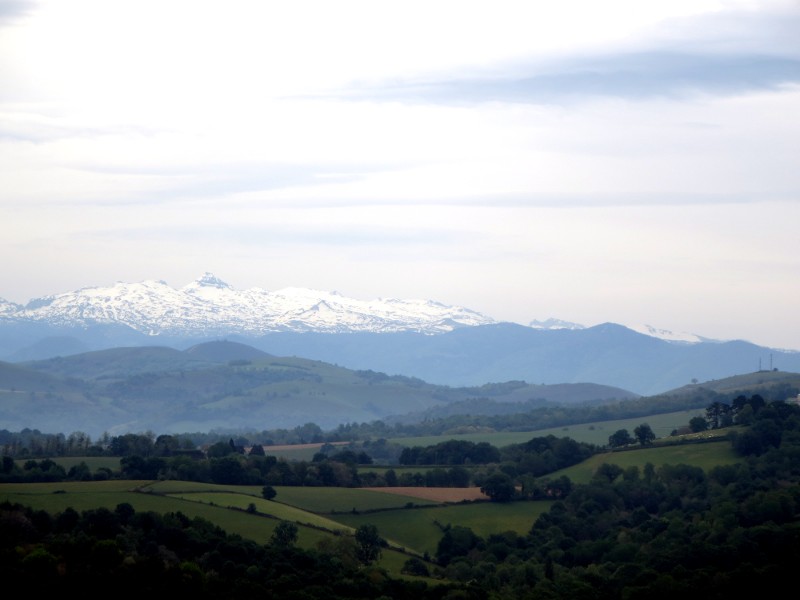 Snow on the Pyrenees to the southeast |
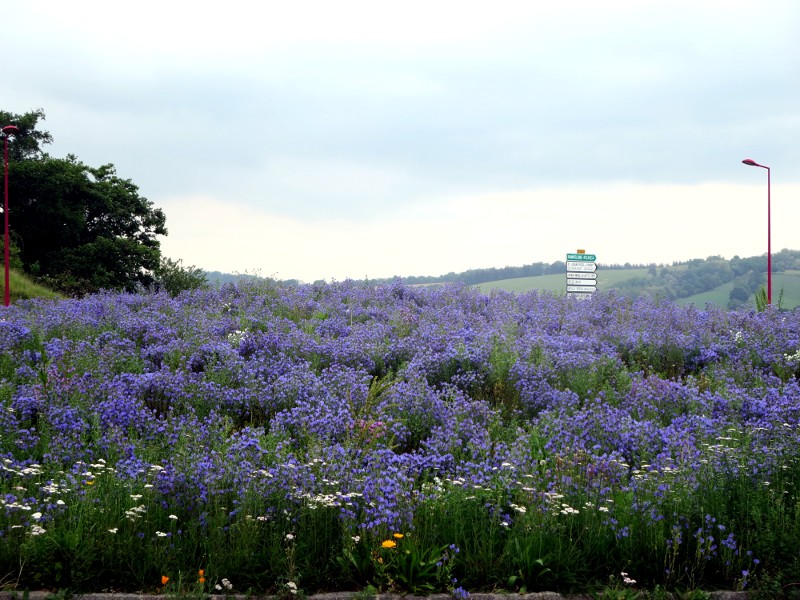 Flowers in the St. Palais roundabout |
Cindy had not had lunch before we arrived, so we found a bar which sold sandwiches, and she ate while I had a beer. Then we wandered about town, until we found the local cathedral, the interior of which was gorgeous. Later on that night, after dinner, we returned to the room to find dancing in the square outside. They seemed to be having fun.
 |
 |
 Dancing in the square |
Tuesday, Jack and Cindy taxied to Larceveau, while the rest of us walked the 11 mile distance, which was shorter than we expected, which apparently balanced out the longer day before.The morning offered us a climb of several hundred feet up to the Chapelle de Soyarza, which offered splendid views of the surrounding countryside. Then down to the village of Harambels, with a very old church. The church offered guided tours to groups of 10 or more, which could be scheduled by email... Then we had lunch in another very old village before arriving at Larceveau.
 Chapelle de Soyarza |
 |
 Harambels church |
 Lunch stop |
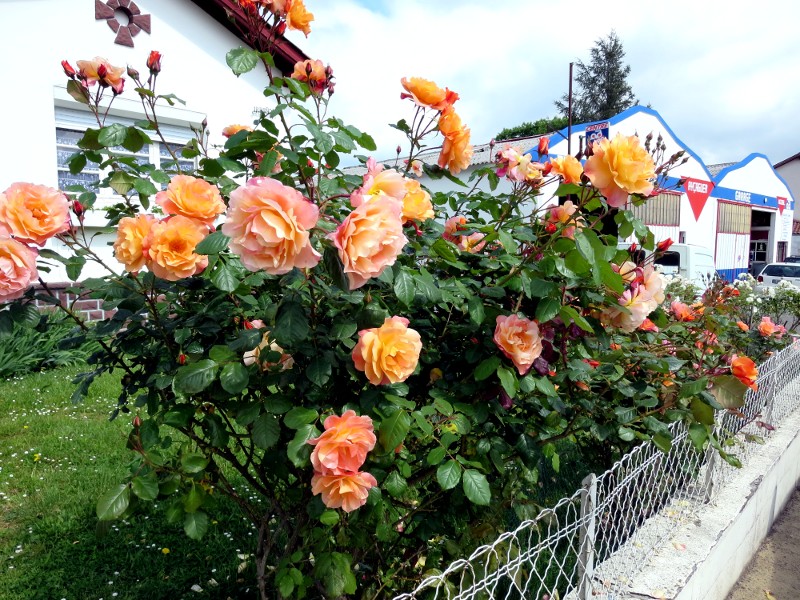 Larceveau is a village of less than 400 people. The hotel and restaurant which services pilgrims is the main feature of town, along with a tiny store which sells a few groceries and other items. The hotel has a large restaurant with a bar. There were some nicely tended houses in the little town, one of which had these gorgeous roses.
Larceveau is a village of less than 400 people. The hotel and restaurant which services pilgrims is the main feature of town, along with a tiny store which sells a few groceries and other items. The hotel has a large restaurant with a bar. There were some nicely tended houses in the little town, one of which had these gorgeous roses.
The next morning, Cindy and Jack rode with the luggage to St. Jean Pied de Port.They had to wait a long time for the man who transported the luggage to show up, and they were understandably bored with hanging around tiny Larceveau with nothing to do. The day had dawned clear, for a change, and we had a lovely walk through the countryside. In the village of Gamarte, where we passed a man driving cattle on a bicycle, we had a slight problem caused by the group being separated. Tristan, Alex, and I went into a cheese shop, where Tristan bought some cheese. Ann took a different route through the village than Wilf and Bob, and passed us while we were inside. We came out of the shop and met Wilf, thinking that Ann and Bob were behind us, when in fact Ann was in front of us. We wandered down the trail, and Wilf stopped to wait for Ann and Bob, when Bob was in the village looking for Ann. So, in the end, we met Ann down the trail, and Wilf and Bob got to do some extra walking when Wilf had to go back to the village to pick up Bob and tell him where Ann was.
Tristan, Alex, Ann, and I continued on to St.-Jean-le-Vieux, where we stopped for lunch. Bob and Wilf caught up there, and we walked into St. Jean Pied de Port together.
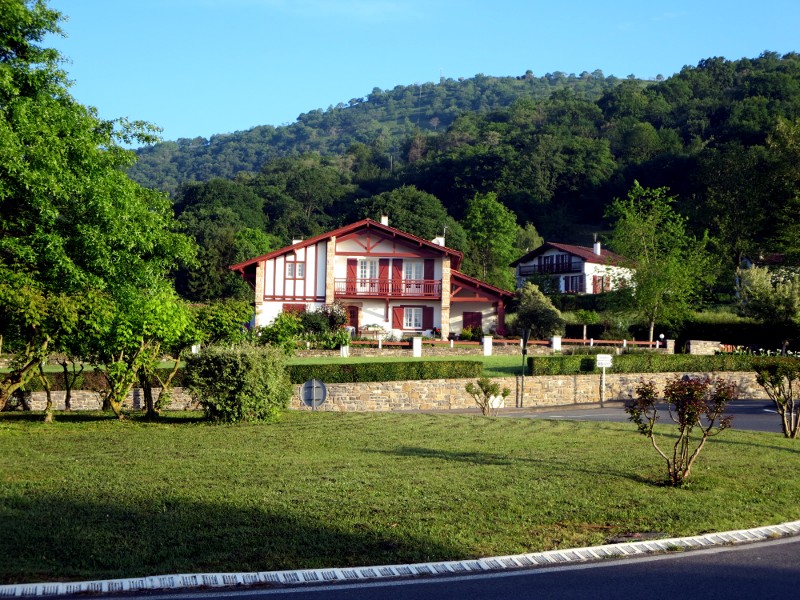 Outskirts of Larceveau |
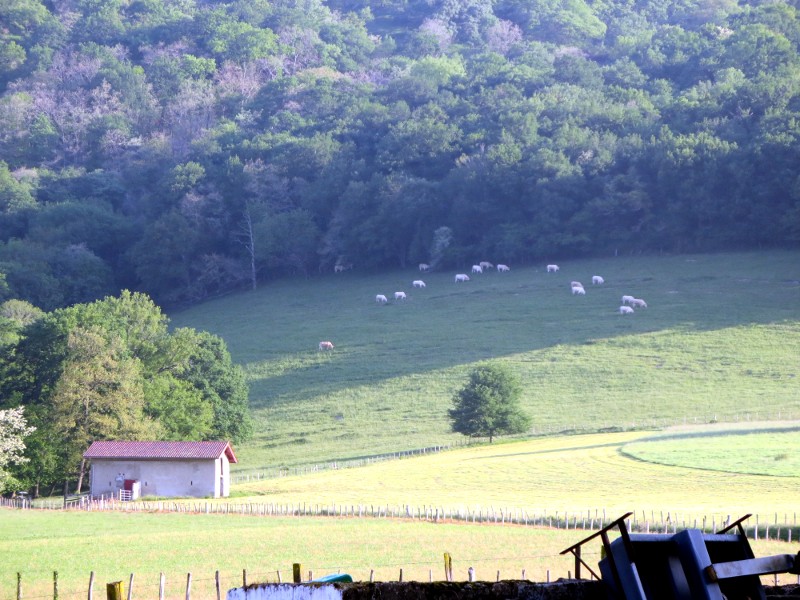 |
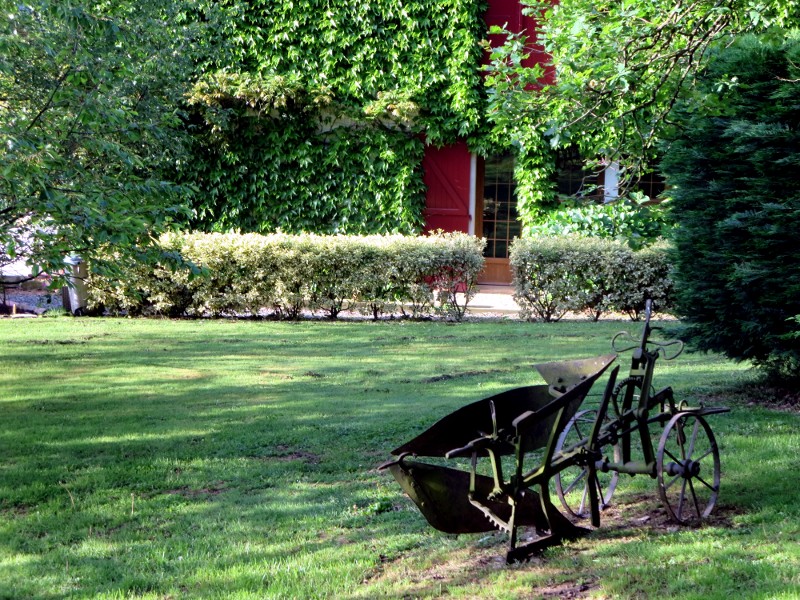 |
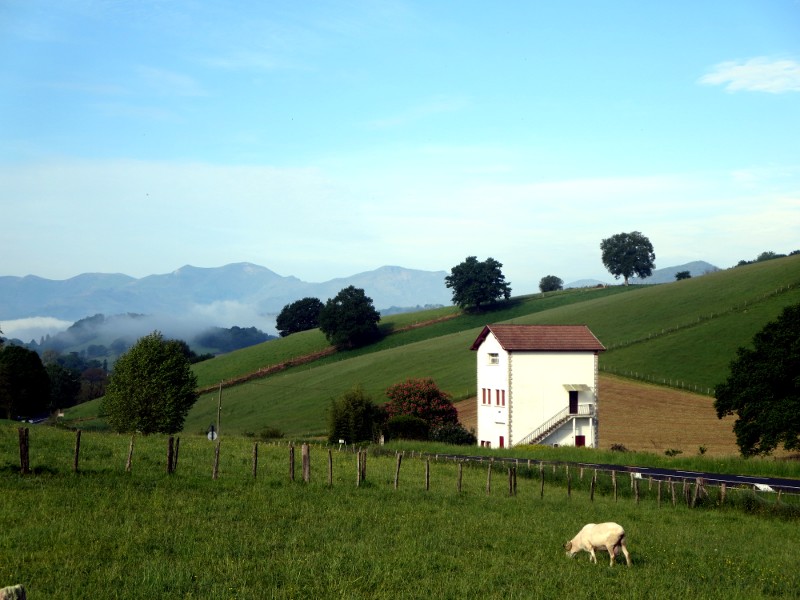 |
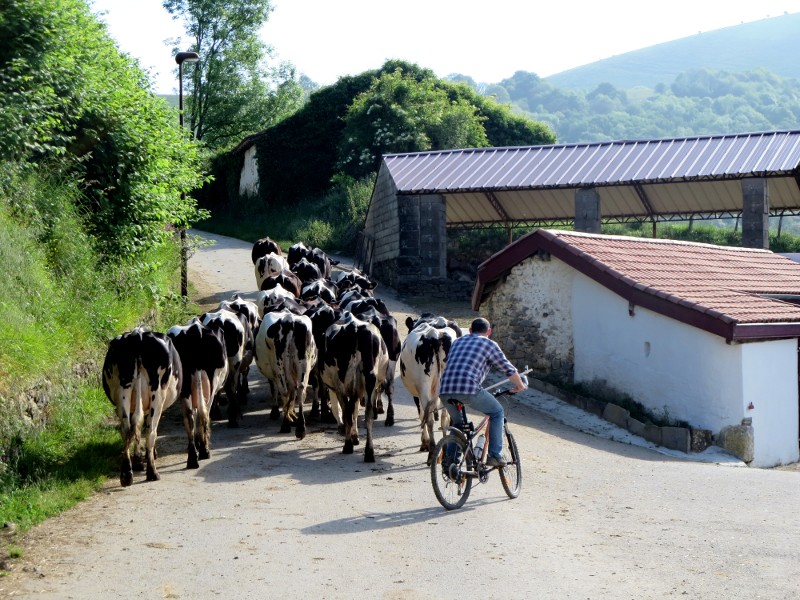 Roll 'em, roll 'em, roll 'em... |
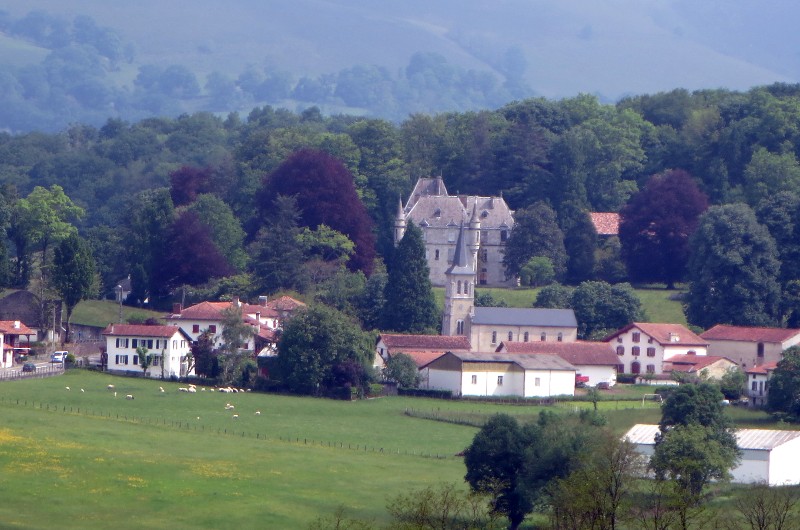 |
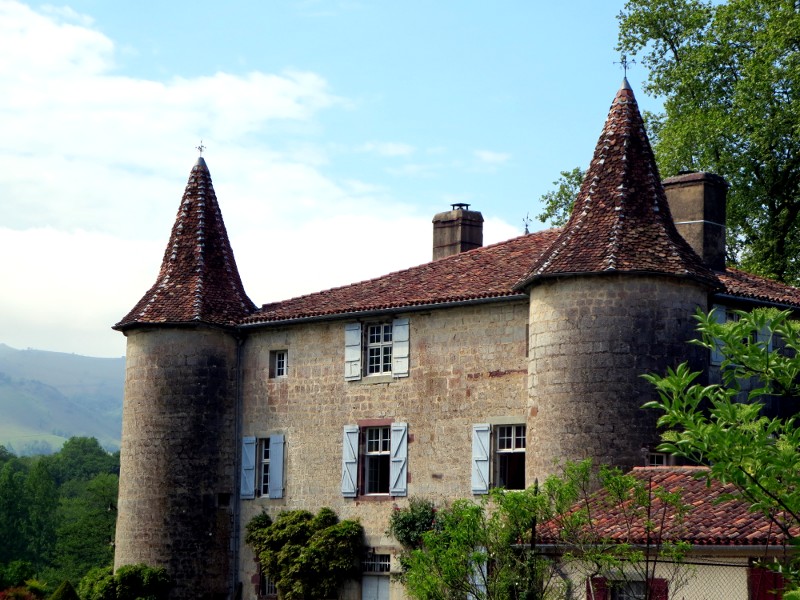 |
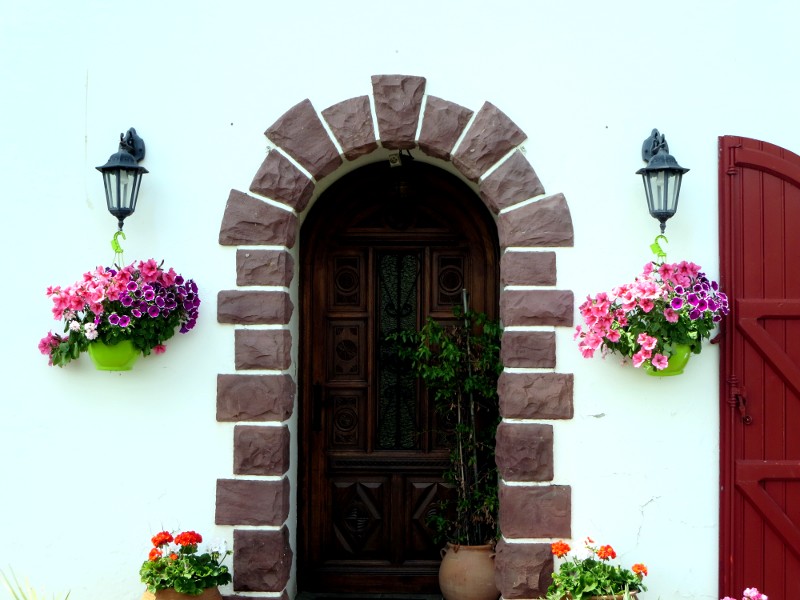 |
St. Jean Pied de Port is a small town at the foot of the Pyrenees, which is traditionally the start of the pilgrimage route known as Camino Frances. The walk from St. Jean Pied de Port to Santiago de Compostela is around 790 kilometers, or about 490 miles. It is an ancient walled city. After walking through the Porte St. Jacques, the gate on the southern end of the old town, we found Jack and Cindy waiting for us on the main street in town. After dropping our bags in our two separate hotels, we all met at the Hotel Central for drinks.
We would remain in town for two nights before walking over the Pynenees to Roncevalles, the end of our hiking trip. The group had dinner both nights in the Hotel Central, which is right on the river Nive running through town. Our room was on the corner of the hotel, and offered splendid views of the river. We slept both nights with the window on the river side cracked, enjoying the noise of the water running over the wier below.
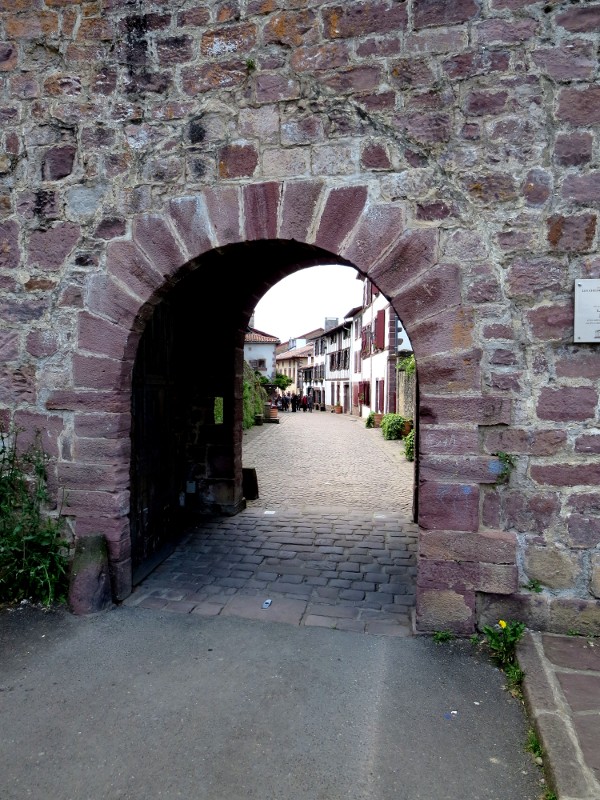 Porte St. Jacques |
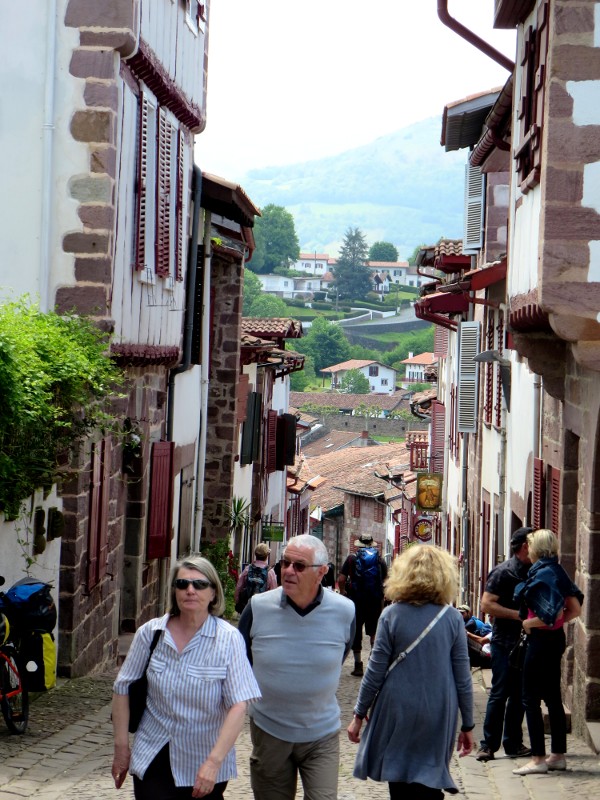 Rue de la Citadelle |
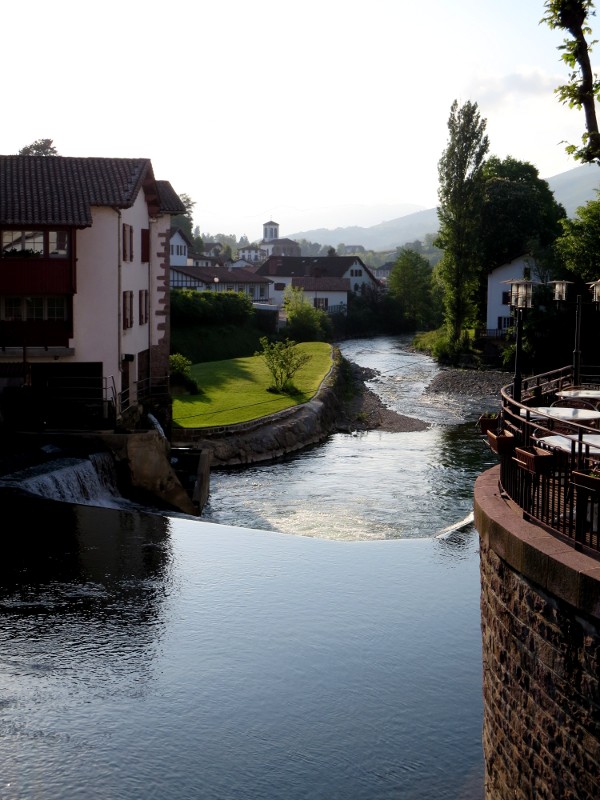 |
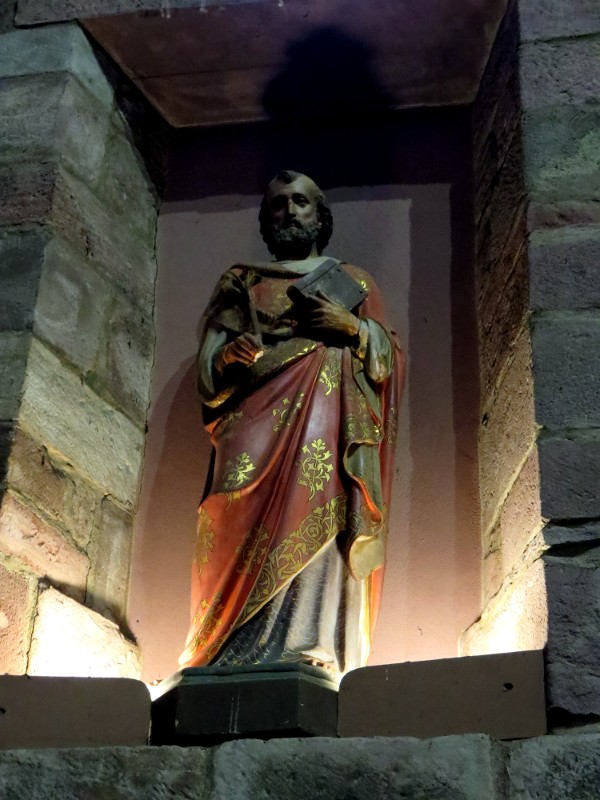 Statue of St. James in the church |
We spent the time wandering through the old town exploring the many shops selling Basque goods and souvenirs, climbing up to the Citadel — which is now a school, and bumping into others of our group from time to time.
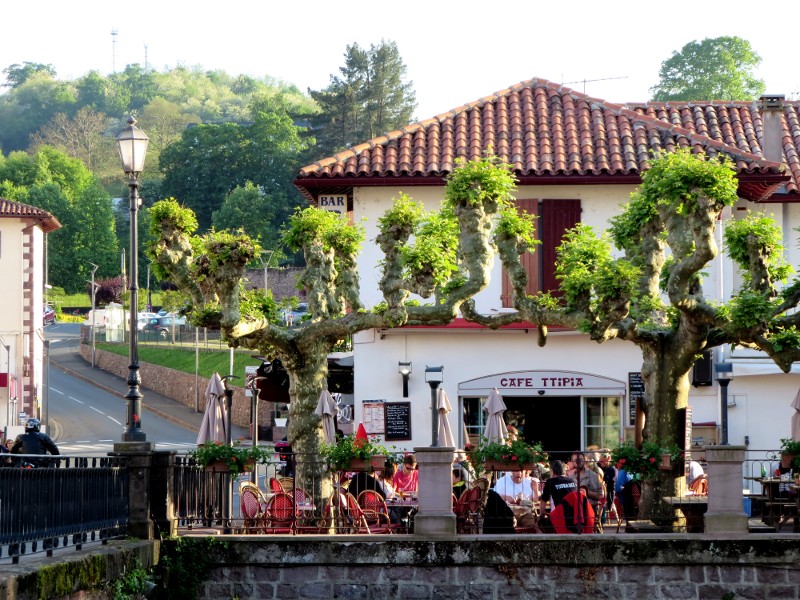 |
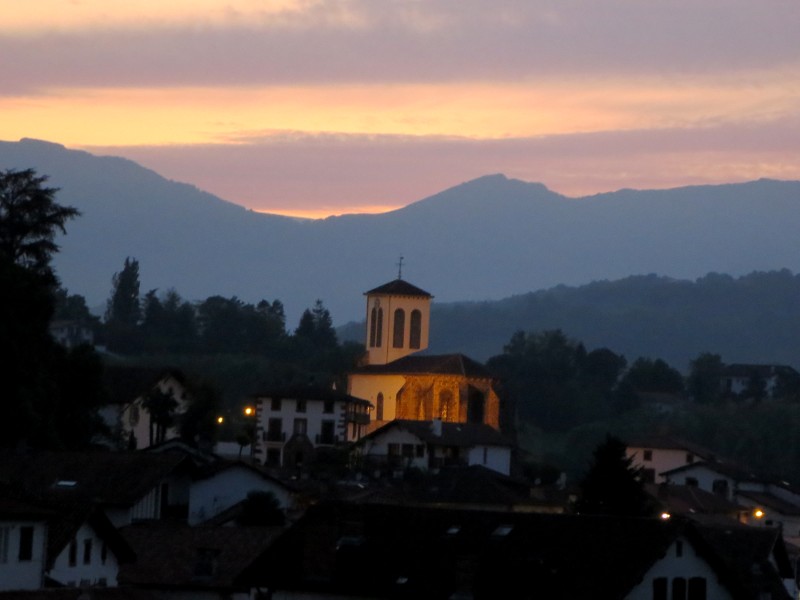 |
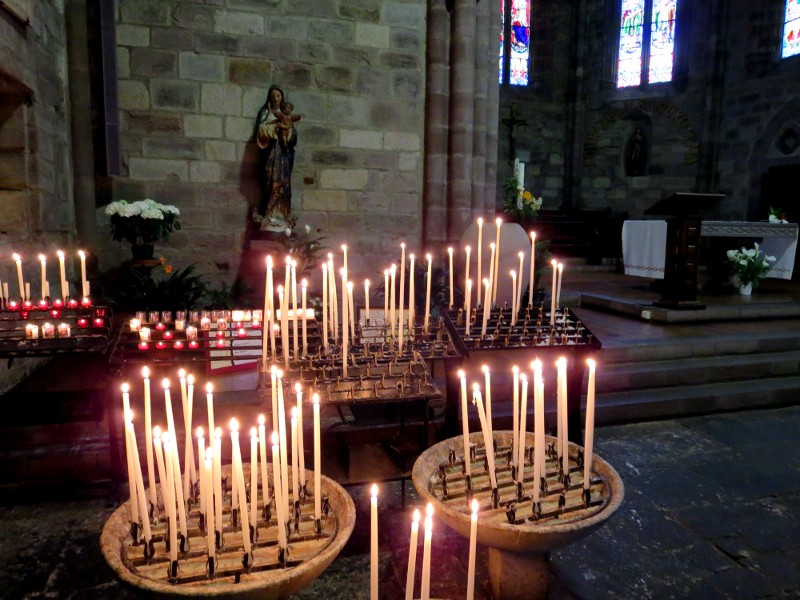 Candles lit by pilgrims in the church |
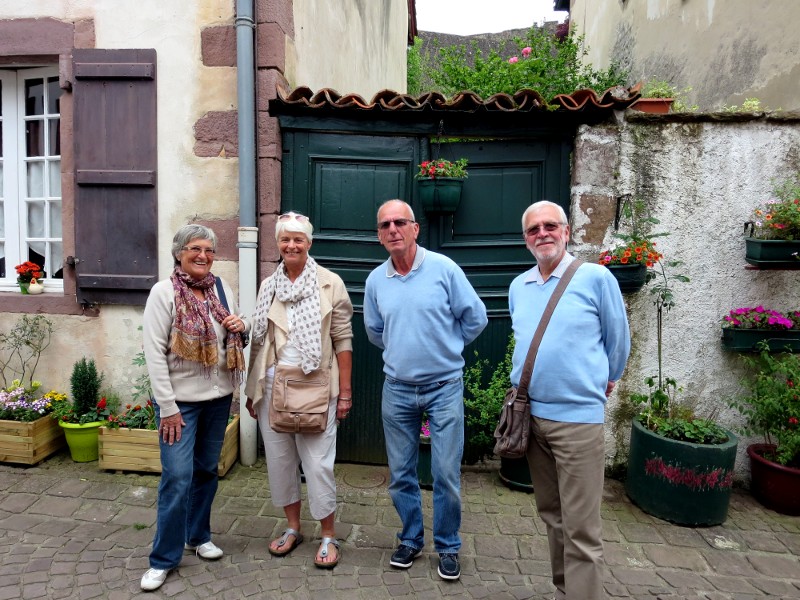 Our French friends |
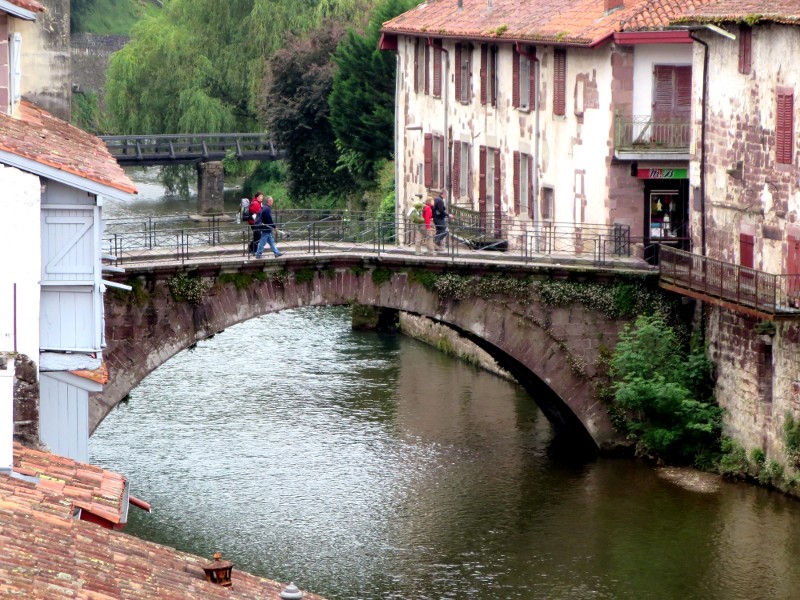
Pilgrims departing from St. Jean, headed south toward the Pyrenees, over the most famous bridge of all.
Cindy's toe had now sufficiently healed that she was eager to walk after four days of idleness, and on Saturday morning the group began the long climb to the summit of the Route Napolean over the Pyrenees, which the French emperor had used to move his troops into and out of Spain during the Peninsular War of the early 1800's. It was also used by pilgrims to avoid the bandits on the longer and lower route through Valcarlos, and was used by smugglers between France and Spain. The first three or four miles from the gate Porte D'Espagne was steep. The countryside we walked through everywhere in France was beautiful — but this day had dawned cool and clear, and offered the best views of the entire trip.
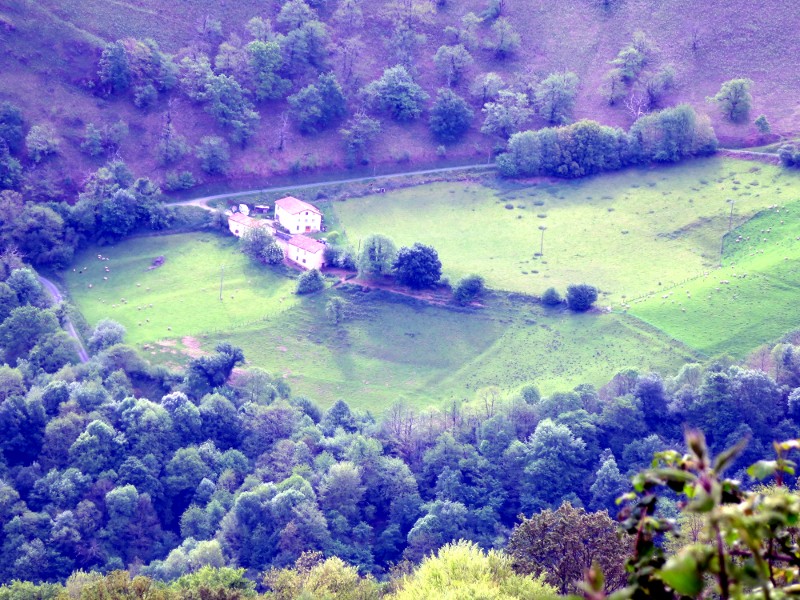 |
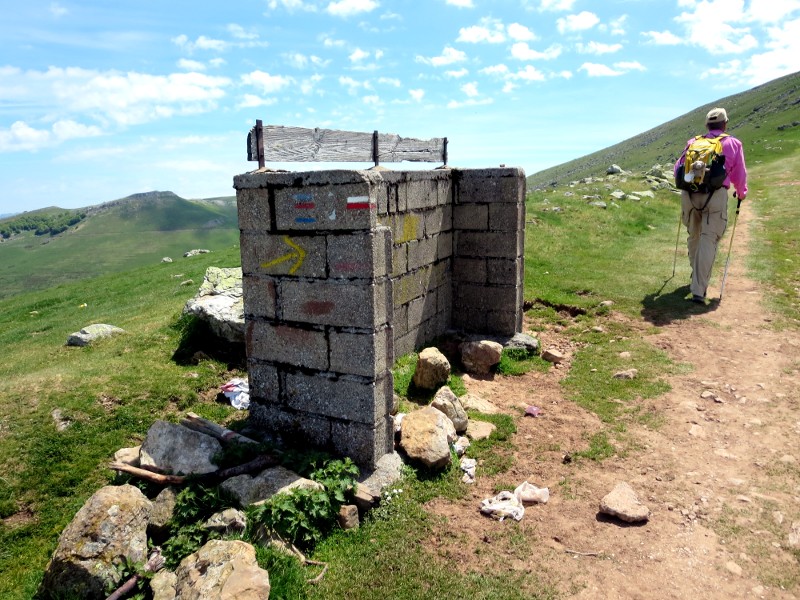 Border marker between Spain and France |
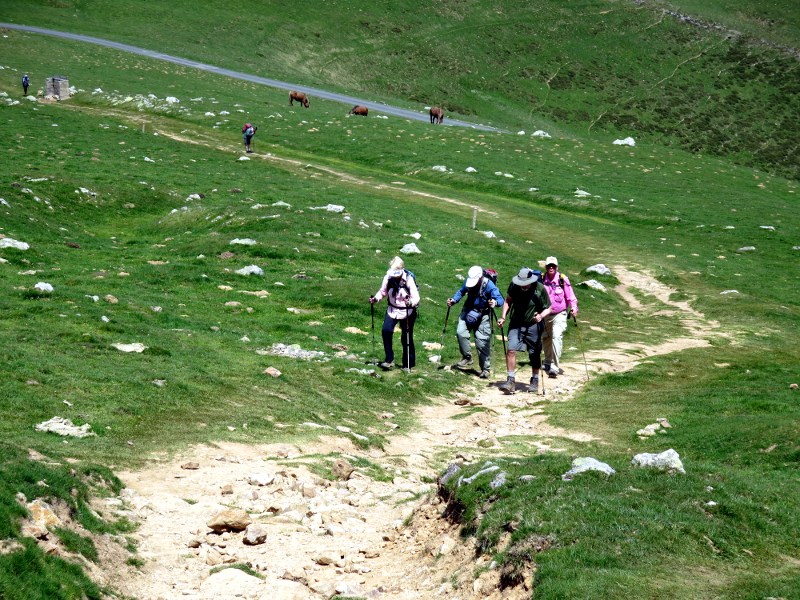 Still climbing... |
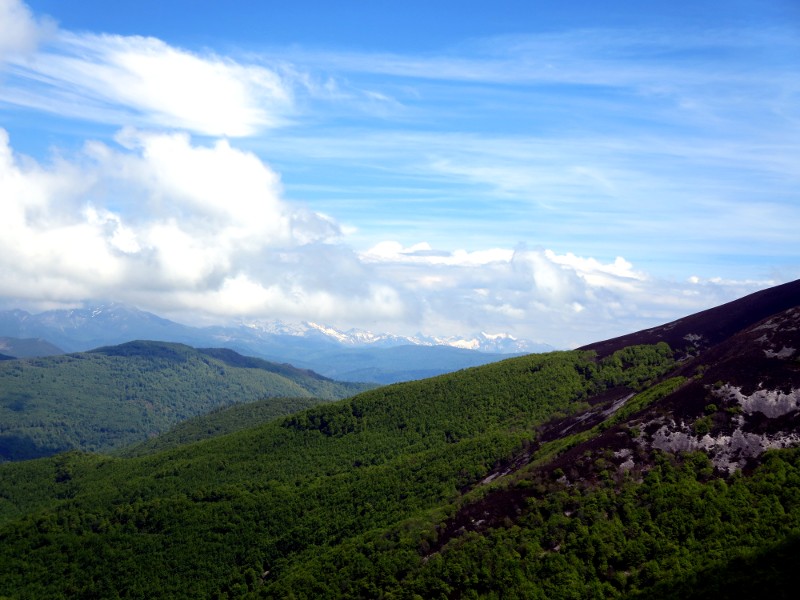 Snow-capped mountains to the east |
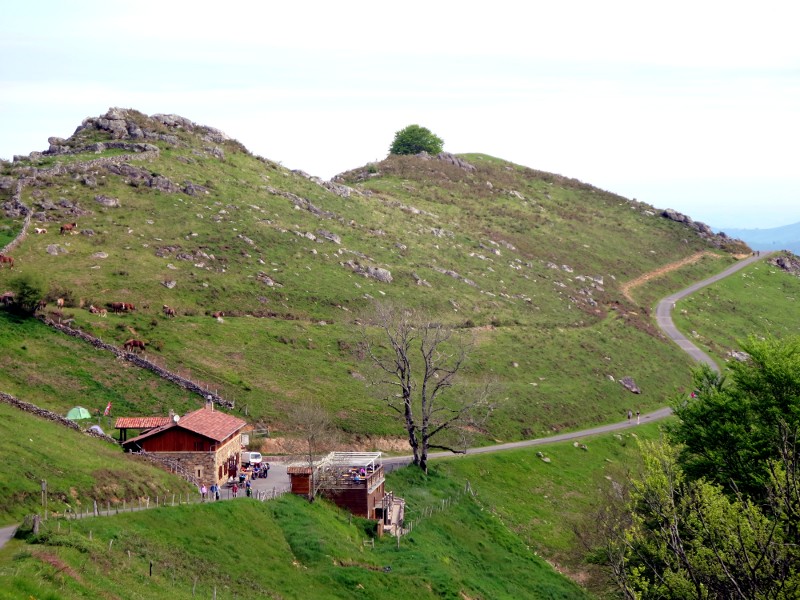 Popular coffee stop |
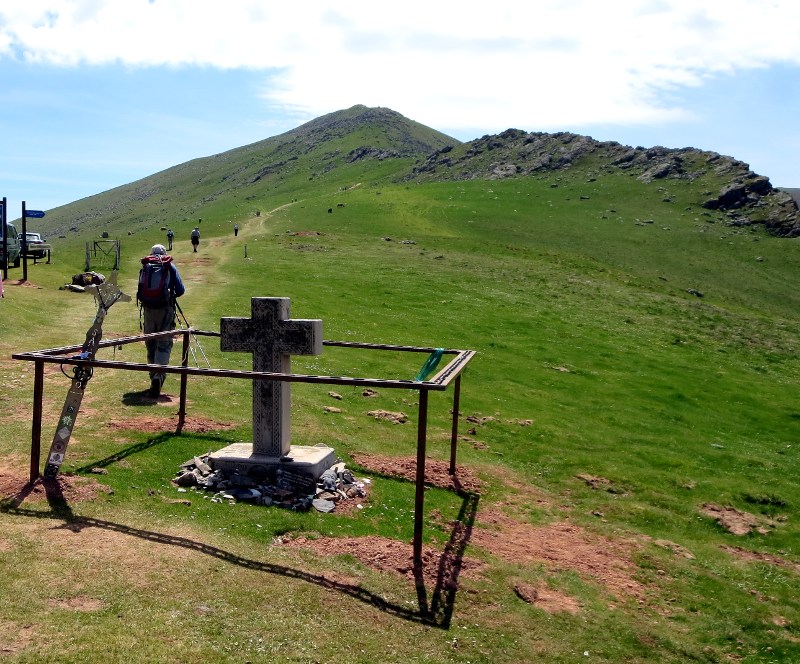 The Croix Thibaut |
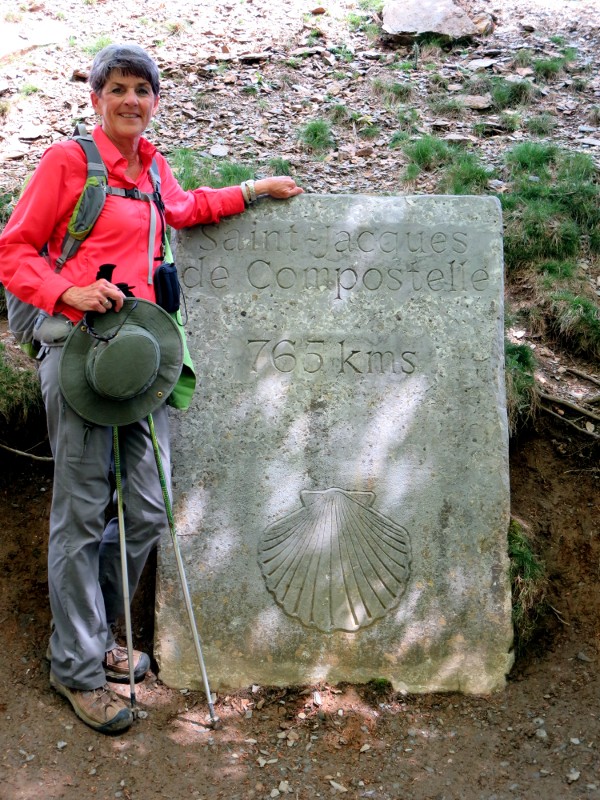 We're not in France anymore... |
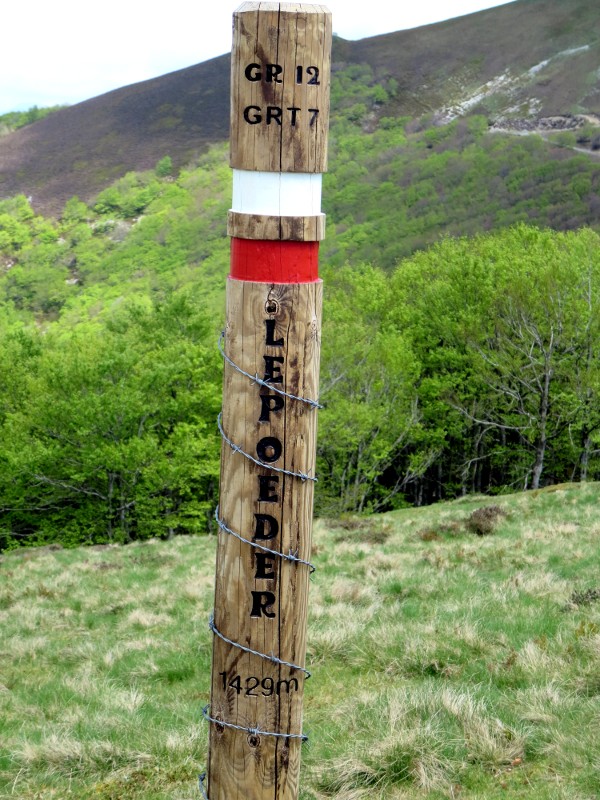 Col de Lepoeder, the high point |
From the Col de Lepoeder, we descended into Roncevalles along the GR12, which offered a more gentle path than sticking to the GR65. And so finished the walk, the entirety of which was around 120 miles, in 9 days of walking, an average of around 13 & 1/2 miles per day.
The monastery at Roncevalles was converted into an albergue to house pilgrims, and the massive complex still retains the structure of the fortress it once was, which included a moat. The hiking party lingered over beer and wine before having dinner in the hotel. All that remained was to re-pack our gear for the trip home.
The next morning, while waiting for the van to the airport in Biarritz, we saw an ancient spectacle of the pilgrimage from Arce Valley and Oroz Betelu to the cathedral in Roncevalles.
 |
 |
 Church being prepared for pilgrims |
 Pilgrims carrying crosses |
The ride from Roncevalles to Biarritz involved a ride from there back to St. Jean, because of regulations involving who could legally provide taxi service between Spain and France, and a switch to another van from St. Jean to the airport. The flight back to Orly in Paris took off an hour and a half late because of weather delays in Paris, and then we took a bus back to Charles de Gaulle airport followed by a shuttle ride to our hotel, so that we didn't have to traverse Paris traffic early on Monday morning for the long flight home.
Charles de Gaulle is a huge airport, with three main terminals and a host of sub-terminals. Our flight took off from terminal 2E, which we found without difficulty — the terminals are pretty well marked. We checked in our bags at Air France, using the "express" kiosk to print boarding passes and luggage tags, and this time, the kiosk really did provide an express, as we there was a quick dropoff for just the bags. We got through passport control and security without difficulty, and got breakfast in a small restaurant in the gate area. We spent some time shopping in the many shops in the gate area, and actually found a necklace which matched a set of Swarovski earrings that Cindy had been given by her daughter-in-law Allison Crochet. Our timing — we arrived at the airport almost 3 hours before the flight — was perfect, because shortly after we got through security, there was a huge backup at security as others arrived for morning flights.
The 8 & 1/2 hour flight back to Atlanta, in a reasonably new Air France Boeing 777, was uneventful, and we watched movies on the seatback screens in front of us. There was a wide selection of movies to choose from, and we both watched 12 Years a Slave, which won several well-deserved Academy Awards. I did not mention to Cindy until we landed in Atlanta that Boeing 777 was the same model aircraft which disappeared on a flight from Malaysia to Bejing, an aircraft at this writing still not found, for which she was grateful...
Clearing passport control and customs in Atlanta was easy after a short wait. We had unfortunately arrived the day before automated passport control terminals were to be put into use, so we had a short wait to get ours checked. Then we rechecked our bags for the flight from Atlanta to New Orleans. After lunch in the terminal — we had chips, salsa, and guacamole to satisfy our cravings for Mexican food not on offer in France, and I had a $9.30 beer — before boarding the flight which took off about 35 minutes late, arriving home after a day which was about 24 hours long by the time we got to bed.
What a trip! Who knows what next year will bring?
All Rights Reserved